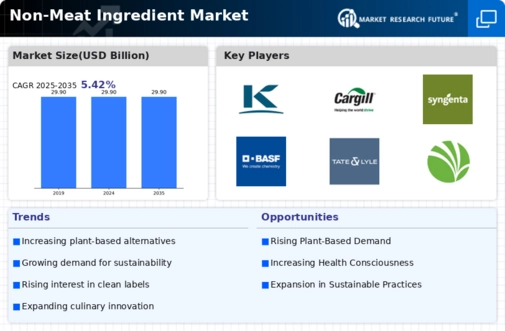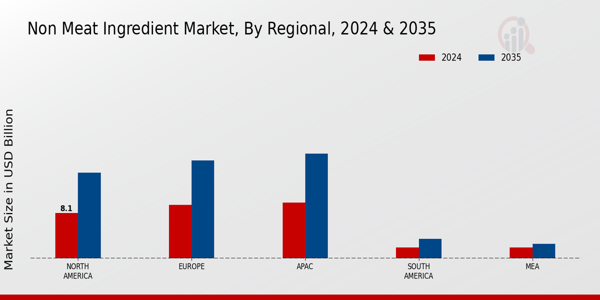Market Growth Projections
The Global Non-Meat Ingredient Market Industry is projected to maintain a stable value of 29.9 USD Billion from 2024 to 2035, with a CAGR of 0.0% during the period. This stability suggests a mature market where growth may be limited but consistent. Factors such as health consciousness, sustainability, and technological advancements contribute to this steady state. While the market may not experience rapid expansion, it appears to be resilient, reflecting a sustained interest in non-meat ingredients among consumers. This stability could indicate a shift towards a more balanced market, where innovation and consumer preferences continue to shape the landscape.
Rising Health Consciousness
The Global Non-Meat Ingredient Market Industry experiences a surge in demand driven by increasing health consciousness among consumers. Individuals are increasingly seeking alternatives to meat due to concerns over health issues such as obesity, heart disease, and diabetes. This shift is reflected in the growing popularity of plant-based diets and meat substitutes, which are perceived as healthier options. As a result, the market is projected to maintain a value of 29.9 USD Billion in 2024, indicating a stable consumer preference for non-meat ingredients. This trend suggests a long-term commitment to healthier eating habits, which could sustain the market's growth trajectory.
Sustainability and Environmental Concerns
Sustainability plays a pivotal role in shaping the Global Non-Meat Ingredient Market Industry. Consumers are increasingly aware of the environmental impact of meat production, including greenhouse gas emissions and resource depletion. This awareness drives demand for non-meat ingredients that are perceived as more sustainable. For instance, plant-based proteins and alternative ingredients are gaining traction as eco-friendly options. The market's stability at 29.9 USD Billion in 2024 reflects a growing consumer inclination towards sustainable food choices. This trend may continue to influence purchasing decisions, as individuals seek to align their diets with environmentally responsible practices.
Changing Dietary Preferences and Lifestyles
The Global Non-Meat Ingredient Market Industry is significantly impacted by evolving dietary preferences and lifestyles. As more consumers adopt vegetarian and vegan diets, the demand for non-meat ingredients rises correspondingly. This shift is often driven by ethical considerations, health benefits, and the desire for culinary diversity. The market's projected value of 29.9 USD Billion in 2024 indicates a robust consumer base seeking innovative non-meat options. As dietary trends continue to evolve, it is plausible that the market will adapt to meet the changing needs of consumers, potentially leading to sustained growth in the sector.
Regulatory Support for Plant-Based Products
Regulatory frameworks increasingly support the Global Non-Meat Ingredient Market Industry, promoting the development and acceptance of plant-based products. Governments worldwide are implementing policies that encourage the consumption of non-meat alternatives, often in response to public health and environmental concerns. For example, subsidies for plant-based agriculture and labeling regulations for meat alternatives enhance market visibility and consumer trust. This supportive regulatory environment contributes to the market's stability at 29.9 USD Billion in 2024, suggesting that favorable policies may continue to bolster the growth of non-meat ingredients in the coming years.
Technological Advancements in Food Production
Technological innovations significantly influence the Global Non-Meat Ingredient Market Industry. Advances in food technology, such as improved extraction methods and fermentation processes, enhance the quality and variety of non-meat ingredients. These innovations enable manufacturers to create more appealing and nutritious products, catering to diverse consumer preferences. The market's projected value of 29.9 USD Billion in 2024 underscores the potential for growth driven by these advancements. As technology continues to evolve, it is likely to facilitate the development of novel non-meat ingredients, further expanding the market and attracting a broader consumer base.

















